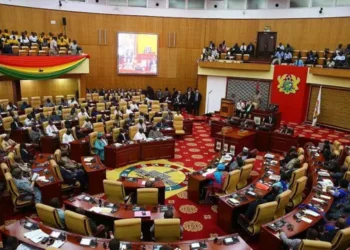Buildings still smouldered and shopkeepers sifted through the ashes of their livelihoods in central Nairobi, Kenya on Thursday, following a night of widespread looting and arson.
The destruction unfolded after mass demonstrations led by Kenyan youth, during which rights group Amnesty Kenya reported that 16 people were shot dead, allegedly by police officers.
Thousands poured into the streets on Wednesday, marking one year since deadly anti-tax protests left more than 60 dead. The recent unrest was further fueled by the death of blogger Albert Ojwang, who died in police custody after being detained over a complaint filed by Deputy National Police Chief Eliud Lagat. An autopsy revealed he had been beaten in jail.
In response to the latest wave of demonstrations, police deployed tear gas and water cannons to disperse crowds across Nairobi and several other towns. However, clashes escalated into violence overnight, leaving at least ten buildings in Nairobi’s downtown torched and plumes of smoke rising into the morning sky.
Ibrahim Hamisi, who owns one of the destroyed properties, pleaded for dialogue between the government and demonstrators.
“Look: everything they burnt. So please government, try talking to the Gen Z. Because this happened [because] of Gen Z. So Gen Z, try to sit down and talk with the government.”
Ibrahim Hamisi
The youth, many identifying with the informal “Gen Z” movement, have been central to these protests, which began last year in opposition to a proposed tax hike and have now evolved into a broader rejection of police brutality, political exclusion, and economic despair.
Shopkeeper Josephine Apondi recounted the looting of her electronics store, estimating her losses at 2 million Kenyan shillings (about $15,500).
“Things are so tough in our country right now. Sometimes we come morning until evening and we have not sold. And to remember this is something you have invested in for so long.”
Josephine Apondi
Reports from Kenya indicated that similar scenes of violence and vandalism occurred in at least 26 other counties where protests took place.
Amnesty Kenya’s executive director Irungu Houghton stated that all 16 people killed on Wednesday died of gunshot wounds. Authorities have yet to confirm or comment on the number of casualties or allegations of police shootings. Police spokesperson Muchiri Nyaga has not issued a public response.
In the case of Albert Ojwang, prosecutors have filed murder charges against six individuals, including three police officers. All have entered not guilty pleas.
Violent Protests and Underlying Issues
The surge in violence among protesting youth is reflective of deeper societal strains. Young Kenyans aged 18–34 are increasingly frustrated by high unemployment, poor governance, and a lack of meaningful political inclusion. Many demonstrations begin peacefully but quickly deteriorate into confrontations with law enforcement, further eroding trust between citizens and state institutions.

The youth-driven unrest, often unstructured but powerfully symbolic, seeks to challenge entrenched political practices and demand more responsive, inclusive leadership. However, the state’s often aggressive response, marked by beatings, arrests, and live ammunition, has intensified the situation.
What is unfolding in Kenya is not just a wave of protests, it is a generational outcry against a system perceived as broken. The use of excessive force by authorities only reinforces perceptions of impunity and marginalization.
If left unaddressed, this trend risks destabilizing Kenya’s political landscape and undermining prospects for peaceful democratic engagement. The challenge ahead lies in addressing the root causes of youth discontent and fostering inclusive dialogue to prevent further violence and build a more equitable future for Kenya’s youth.
READ ALSO: Hamza Suhuyini Demands Exit of Suspended Chief Justice



















